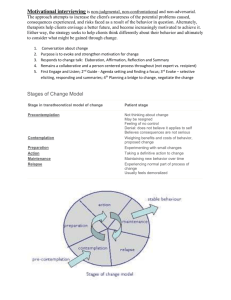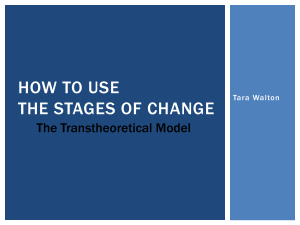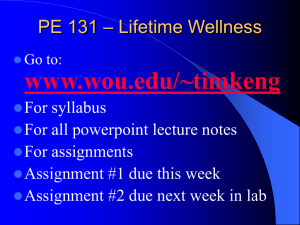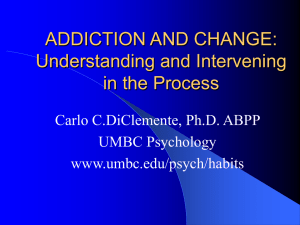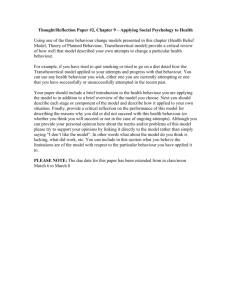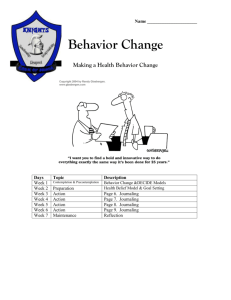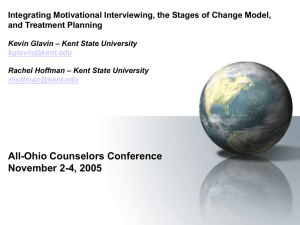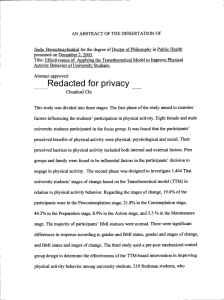Chapter 6 - Routledge
advertisement
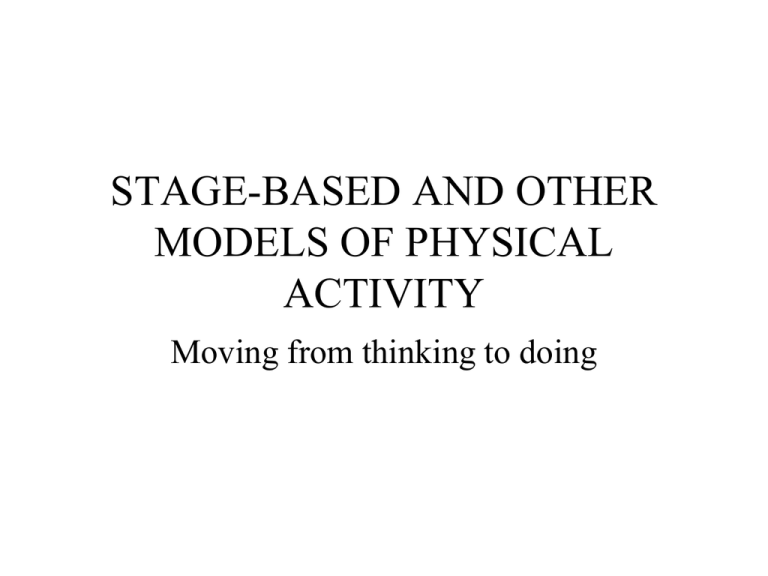
STAGE-BASED AND OTHER MODELS OF PHYSICAL ACTIVITY Moving from thinking to doing Theories of Exercise Behaviour Belief-Attitude Theories Competence-Based Theories Control-Based Theories Stage-Based Theories Hybrid Models Example: Theory of Planned Behaviour Example: Self-Efficacy Theory Example: Self-Determination Theory Example: Transtheoretical Model Example: HAPA Aims • • • • To outline the popular ‘Transtheoretical Model’ approach to physical activity decision-making Cover the ‘natural history’ model of exercise proposed by Sallis and Hovell (1990) Outline the relapse prevention model Describe the lifespan interaction model The Transtheoretical Model of Health Behaviour Change • • • • • Core constructs: Stages of change Processes of change Decisional balance (pros and cons) Self-efficacy The Transtheoretical Model HOW Self-Efficacy Decisional Balance Processes of change WHEN Precontemplation Contemplation Preparation Action Maintenance Precontemplation • Physically active? NO • Intention to be active? NO Contemplation • Physically active? NO • Intention to be active? YES Preparation • Physically active? Yes, but not at criterion level • Intention to be active? YES Action • Physically active? YES (less than 6 months) • Intention to be active? YES Maintenance • Physically active? YES (more than 6 months) • Intention to be active? YES Prevalence estimates for stages by different levels of physical activity 100% 90% 80% 70% 60% 50% 40% 30% 20% 10% 0% Main Action Prep Cont Pre 3x15m 3x15MVPA 47x30MVPA None (Marshall & Biddle, 2001) Prevalence estimates for stages across four countries 100% 90% 80% 70% 60% 50% 40% 30% 20% 10% 0% Main Action Prep Cont Pre Australia Canada UK USA Total (Marshall & Biddle, 2001) Stages are thought to be cyclical Maintenance Preparation Action Contemplation Precontemplation Processes of change • "the cognitive, affective, and behavioral strategies and techniques people use as they progress through the different stages of change over time" (Marcus et al., 1992) Processes of change Process Description COGNITIVE / THINKING PROCESSES Increasing knowledge Increasing information about oneself and physical activity. Being aware of risks Understanding the risks of inactivity and sedentary living. Caring about consequences to others Recognising how inactivity might affect others, such as family and co-workers. Increasing healthy alternatives Increasing awareness of alternatives for being physically active. Understanding the benefits Increasing awareness of the benefits of physical activity. Processes of change BEHAVIOURAL / DOING STRATEGIES Substituting alternatives Seeking ways of being physically active when encountering barriers of time etc. Enlisting social support Seek support from others for your physical activity efforts. Rewarding yourself Praise and reward yourself, in a healthy way, for making successful efforts in physical activity. Committing yourself Make plans and commitments for physical activity. Reminding yourself Establish reminders and prompts for physical activity, such as diary time slots and making equipment easily available. DECISIONAL BALANCE Pros & cons of exercising • I would be healthier if I exercised (pro) • Other people would respect me more if I exercised (pro) • It is expensive to join a health club (con) • I would probably be sore and uncomfortable if I exercised (con) Differences in pros and cons across Effect Size stages (Marshall & Biddle, 2001) 2 1.5 1 0.5 Cons Pros 0 Precontemplation Contemplation Preparation Maintenance Action Self Efficacy The confidence that you can be active in challenging situations Example: I am confident I can be active when I feel I do not have much time Differences in self-efficacy across stages (Marshall & Biddle, 2001) Effect Size 2.5 2 1.5 1 0.5 0 Precontemplation Preparation Contemplation Maintenance Action TTM: Critique • the majority of study designs are cross-sectional • there is a need to standardize and improve the reliability of measurement of stages and related constructs • the role of processes of change for physical activity behaviour remains unclear. The presence of higher-order constructs is not apparent in physical activity • stage-by-process interactions are not evident (Marshall & Biddle, 2001) A NATURAL HISTIORY MODEL OF EXERCISE MAINTENANCE SEDENTARY RESUMPTION ADOPTION DROPOUT Determinants may differ across phases/stage of the model • • • • • Key phases/stages applied to exercise: Starting exercise Maintaining exercise Ceasing exercise Resuming exercise RELAPSE PREVENTION MODEL Adequate or increased self-efficacy Low probability of quitting High risk of ceasing exercise Low selfefficacy Negative attributions High probability of quitting Lifespan Interaction Model (to be inserted by publisher?) Chapter 6: Conclusions 1 • • • • the TTM provides an important advance on static linear models of exercise and physical activity determinants by hypothesising both the ‘how’ and ‘when’ of behaviour change Measures of stages and processes of change are now available and require validation across more diverse samples TTM research needs to advance beyond description of predictable cross-sectional differences between stages meta-analytic evidence broadly supports the model, although the classification of processes of change into two higher-order categories is questioned Chapter 6: Conclusions 2 • • • • a natural history model of exercise is a useful framework for identifying key stages in exercise behaviour more needs to be known about which determinants are important at each of the phases of the model relapse prevention may depend more on coping strategies than high-risk situations per se the hybrid HAPA model allows for the distinction between non-intentional, intentional, and action stages of behaviour
